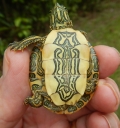Mesoamerican Slider (Trachemys venusta)
Classification: Introduced Species - While the Mesoamerican Slider has been seen and identified in the state of Texas, there are no records of any breeding populations. Sightings of this species are most likely of released or escaped pets that were imported for the pet trade.
Description: The Meso-American Slider has an oval shell with sharp edges. Their shells are longer than they are wide and they have a low lateral profile. It has a rough surface with indentations that vary in direction; the ventral side is flat and smooth. They are the most beautiful colored turtle of the group having an olive to bright green shell that is marked with numerous dark-centered, orange-ringed spots. Their heads and legs have yellow stripes. Their skin is dark green and brown and they have a wide yellow or red blotch behind the eyes. They maintain these marking and colors from birth except the very old males turn dark. The heads are large and oblong that end in snouts that point upwards, that are covered with smooth skin; they have large eyes and a protruding non-hooked snout. The nostrils are located high on the snout. They have webbed feet, short flat forelimbs with five clawed digits, and short hind limbs. Both males and females have foreclaws that are used in courtship; these claws may be longer in males than in females Their tails are moderately long with males having longer tails than females.
Habitat: The Meso-American Slider Turtle is found in large rivers, ponds, canals and marshes in areas that hold fresh water year-round and have an abundance of vegetation. If present they can be found in large numbers. They are gregarious. During dry periods they will migrate to areas that have water. They are largely aquatic, spending the majority of their daylight hours basking on logs and rocks. They will plunge into the water when disturbed. They are seldom found far from water and will only leave the water environment to nest and forage. The Meso-American Slider Turtle maintain their body temperatures between 65℉ and 92℉. They have a relatively high tolerance for cold temperatures and able to survive short cold weather episodes as low as 7℉. They rely solely on basking to maintain appropriate body temperatures.
Range: Introduced in areas around Houston and San Antonio, Texas.
Found in these States:
TX
Diet: Their diet includes carrion, fish, frogs, shrimp, water snakes, snails, tadpoles and aquatic vegetation such as duckweed. The juveniles are carnivores and as they mature, they add aquatic plants to their diets.
Reproduction: Reproduction occurs during the the warmer months with each female selecting a location and building a nest within 1.6 km (1.0 miles) of their aquatic home. Their nest is a simple oval shaped hole that is 10 cm (4.0 inches) to 14 cm (5.5 inches) deep dug in a wide variety of substrates but in the open to allow ample assess to basking making both themselves and their eggs at greater risk to predation. Reproduction is polygynandrous (promiscuous) and oviparous where a female will pair with several males and a male with pair with several females. Mating occurs every 10 to 46 days during the breeding season with each female laying 1 to 4 clutches comprised of 6 to 11 eggs per year. Once the eggs are deposited into the nests no additional parental care is provided. Incubation periods range from 60 to 95 days. Some hatchlings leave the nest almost immediately while others can stay in the nests for up to 10 months surviving on the yolks from their eggs for sustenance. Later emerging juveniles have greater survival rates. Hatchings range in length from 1.0 inch to 1.4 inches and are miniature adults. The females will utilize the same nesting location on a continual basis. Most interesting the sex of hatchlings from a specific nest is temperature-dependent. Nests that are maintained below 84℉ develop only males. Nests above 85℉ develop only females. Nests at temperatures between 84℉ and 85℉ develop as a mix of males and females.
Status: From a conservation perspective the Meso-American Slider Turtle is currently considered to be of Least Concern with stable, widely distributed populations. They are utilized by some cultures for human food and considered a delicacy in China. They are in high demand and utilized extensively by the pet trade due to their color, adaptability to captivity. They will take food from the hand of the feeder but also known to bite. They require large aquariums and a high level of maintenance however. They have sharp claws and can be aggressive towards other turtles. Approximately 500,000 of these turtles are exported alive from the United States to Japan each year. They have been introduced globally and in many areas are considered to be highly invasive.
Subspecies: None in our range.
»» Kingdom: Animalia - Animals
»» Phylum: Chordata - Chordates
»» Subphylum: Vertebrata - Vertebrates
»» Class: Reptilia - Reptiles
»» Order: Testudines - Turtles & Tortoises
»» Family: Emydidae - Pond, Marsh, & Box Turtles
»» Genus: Trachemys
»» Species: Trachemys venusta - Mesoamerican Slider
»» Subspecies: None
This article uses material from the Wikipedia article "Meso-american Slider", which is released under the Creative Commons Attribution-Share-Alike License 3.0. Content may have been omitted from the original, but no content has been changed or extended.
|








